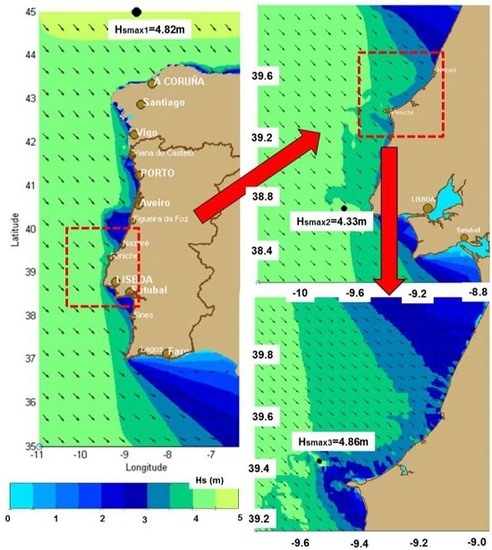High-Resolution Wave Energy Assessment in Shallow Water Accounting for Tides
Abstract
:1. Introduction
2. Wave Modelling in the Portuguese Nearshore
3. Study of the Tide and Wind Influences in the High Resolution Computational Domain
4. Results and Discussion
5. Conclusions
Acknowledgments
Author Contributions
Conflicts of Interest
References
- European Renewable Energy Council (EREC). Mapping Renewable Energy Pathways towards 2020; EU Roadmap: Brussels, Belgium, 2011. [Google Scholar]
- The European Marine Energy Centre (EMEC). Assessment of Wave Energy Resource; The European Marine Energy Centre Ltd.: London, UK, 2009; p. 36. [Google Scholar]
- Clement, A.; McCullen, P.; Falcao, A.; Fiorentino, A.; Gardner, F.; Hammarlund, K.; Lemonis, G.; Lewis, T.; Nielsen, K.; Petroncini, S.; et al. Wave energy in Europe: Current status and perspectives. Renew. Sustain. Energy Rev. 2002, 6, 405–431. [Google Scholar] [CrossRef]
- Silva, D.; Bento, A.R.; Martinho, P.; Guedes Soares, C. High resolution local wave energy modelling for the Iberian Peninsula. Energy 2015, 91, 1099–1112. [Google Scholar] [CrossRef]
- Rusu, E.; Guedes Soares, C. Wave energy assessments in the coastal environment of Portugal continental. In Proceedings of the 27th International Conference on Offshore Mechanics and Arctic Engineering—OMAE 2008, Estoril, Portugal, 15–20 June 2008; Volume 6, pp. 761–772.
- Dalton, G.J.; Alcorn, R.; Lewis, T. Case study feasibility analysis of the Pelamis wave energy convertor in Ireland, Portugal and North America. Renew. Energy 2010, 35, 443–455. [Google Scholar] [CrossRef]
- Cunha, P.P.; Gouveia, M.P. The Nazaré Coast, the Submarine Canyon and the Giant Waves: A Synthesis; Marine and Environmental Sciences Centre: Coimbra, Portugal, 2015; p. 32. [Google Scholar]
- Sebastião, P.; Guedes Soares, C.; Alvarez, E. 44 Years Hindcast of Sea Level in the Atlantic Coast of Europe. Coast. Eng. 2008, 55, 843–848. [Google Scholar] [CrossRef]
- Sauvaget, P.; David, E.; Guedes Soares, C. Modelling Tidal Currents on the Coast of Portugal. Coast. Eng. 2000, 40, 393–409. [Google Scholar] [CrossRef]
- Almeida, M.M.; Guedes Soares, C. Numerical investigation of the tidal energy potential in the Portuguese continental shelf. In Renewable Energies Offshore; Guedes Soares, C., Ed.; Taylor & Francis Group: London, UK, 2015; pp. 177–182. [Google Scholar]
- WaveRoller Concept. Available online: http://aw-energy.com/about-waveroller/waveroller-concept (accessed on 4 December 2015).
- AM Energy & LENA Group. 1 MW Wave Energy Power Plant Peniche—Portugal, Waveroller Technology. 2007. Available online: http://www.cm-peniche.pt/_uploads/pdf_noticias/waverollerawenergyoyeneolicasagrupolena.pdf (accessed on 4 December 2015).
- Rusu, E.; Guedes Soares, C. Numerical modeling to estimate the spatial distribution of the wave energy in the Portuguese nearshore. Renew. Energy 2009, 34, 1501–1516. [Google Scholar] [CrossRef]
- Lucas, J.; Livinstone, M.; Vuorinen, M.; Cruz, J. Development of a wave energy converter (WEC) design tool—Application to the WaveRoller WEC including validation of numerical estimates. In Proceedings of the ICOE 2012, Dublin, Ireland, 17–19 October 2012.
- The Wamdi Group. The WAM model—A third generation ocean wave prediction model. J. Phys. Oceanogr. 1988, 18, 1775–1810. [Google Scholar]
- Booij, N.; Ris, R.C.; Holthuijsen, L.H. A third-generation wave model for coastal regions. I—Model description and validation. J. Geophys. Res. 1999, 104, 7649–7666. [Google Scholar] [CrossRef]
- Rusu, L.; Pilar, P.; Guedes Soares, C. Reanalysis of the wave conditions in the approaches to the Portuguese port of Sines. In Maritime Transportation and Exploitation of Ocean and Coastal Resources; Guedes Soares, C., Garbatov, Y., Fonseca, N., Eds.; Taylor & Francis Group: London, UK, 2005; pp. 1137–1142. [Google Scholar]
- Rusu, L.; Pilar, P.; Guedes Soares, C. Hindcast of the wave conditions along the west Iberian coast. Coast. Eng. 2008, 55, 906–919. [Google Scholar] [CrossRef]
- Rusu, L.; Guedes Soares, C. Evaluation of a high-resolution wave forecasting system for the approaches to ports. Ocean Eng. 2013, 58, 224–238. [Google Scholar] [CrossRef]
- Rusu, E.; Guedes Soares, C. Wave modeling at the entrance of ports. Ocean Eng. 2011, 38, 2089–2109. [Google Scholar] [CrossRef]
- Gonçalves, M.; Rusu, E.; Guedes Soares, C. Evaluation of Two Spectral Wave Models in Coastal Areas. J. Coast. Res. 2015, 31, 326–339. [Google Scholar] [CrossRef]
- Rusu, E.; Gonçalves, M.; Guedes Soares, C. Evaluation of the wave transformation in an open bay with two spectral models. Ocean Eng. 2011, 38, 1763–1781. [Google Scholar] [CrossRef]
- Rusu, L.; Bernardino, M.; Guedes Soares, C. Modelling the influence of currents on wave propagation at the entrance of the Tagus estuary. Ocean Eng. 2011, 38, 1174–1183. [Google Scholar] [CrossRef]
- Guedes Soares, C.; Rusu, L.; Bernardino, M.; Pilar, P. An operational wave forecasting system for the Portuguese continental coastal area. J. Oper. Oceanogr. 2011, 4, 16–26. [Google Scholar] [CrossRef]
- Rusu, L.; Guedes Soares, C. Local data assimilation scheme for wave predictions close to the Portuguese ports. J. Oper. Oceanogr. 2014, 7, 45–57. [Google Scholar] [CrossRef]
- Almeida, S.; Rusu, L.; Guedes Soares, C. Application of the Ensemble Kalman Filter to a high-resolution wave forecasting model for wave height forecast in coastal areas. In Maritime Technology and Engineering; Guedes Soares, C., Santos, T.A., Eds.; Taylor & Francis Group: London, UK, 2015; pp. 1349–1354. [Google Scholar]
- Rusu, L.; Guedes Soares, C. Impact of assimilating altimeter data on wave predictions in the western Iberian coast. Ocean Model. 2015, 96, 126–135. [Google Scholar] [CrossRef]
- Rusu, E.; Guedes Soares, C. Wave energy pattern around the Madeira Islands. Energy 2012, 45, 771–785. [Google Scholar] [CrossRef]
- Rusu, L.; Guedes Soares, C. Wave energy assessments in the Azores islands. Renew. Energy 2012, 45, 183–196. [Google Scholar] [CrossRef]
- Tolman, H.L. A third-generation model for wind waves on slowly varying, unsteady and inhomogeneous depths and currents. J. Phys. Oceanogr. 1991, 21, 782–797. [Google Scholar] [CrossRef]
- Silva, D.; Martinho, P.; Guedes Soares, C. Modeling wave energy for the Portuguese coast. In Maritime Engineering and Technology; Guedes, S.C., Garbatov, Y., Sutulo, S., Santos, T.A., Eds.; Taylor & Francis Group: London, UK, 2012; pp. 647–653. [Google Scholar]
- Silva, D.; Rusu, E.; Guedes Soares, C. Evaluation of various technologies for wave energy conversion in the Portuguese nearshore. Energies 2013, 6, 1344–1364. [Google Scholar] [CrossRef]
- Guedes Soares, C.; Bento, A.R.; Goncalves, M.; Silva, D.; Martinho, P. Numerical evaluation of the wave energy resource along the Atlantic European coast. Comput. Geosci. 2014, 71, 37–49. [Google Scholar] [CrossRef]
- Goncalves, M.; Martinho, P.; Guedes Soares, C. Wave energy conditions in the western French coast. Renew. Energy 2014, 62, 155–163. [Google Scholar] [CrossRef]
- Goncalves, M.; Martinho, P.; Guedes Soares, C. Assessment of wave energy in the Canary Islands. Renew. Energy 2014, 68, 774–784. [Google Scholar] [CrossRef]
- Bento, A.R.; Martinho, P.; Guedes Soares, C. Numerical modelling of the wave energy in Galway Bay. Renew. Energy 2015, 78, 457–466. [Google Scholar] [CrossRef]
- SWAN Team. Scientific and Technical Documentation, SWAN Cycle III Version 41.01; Delft University of Technology, Department of Civil Engineering: Delft, The Netherlands, 2015. [Google Scholar]
- Wang, W.; Barker, D.; Bray, J.; Bruyère, C.; Duda, M.; Dudhia, J.; Gill, D.; Michalakes, J. User’s Guide for Advanced Research WRF (ARW) Modeling System Version 3; Mesoscale and Microscale Meteorology Division—National Center for Atmospheric Research (MMM-NCAR): Boulder, CO, USA, 2007. [Google Scholar]
- Salvacao, N.; Bernardino, M.; Guedes Soares, C. Assessing mesoscale wind simulations in different environments. Comput. Geosci. 2014, 71, 28–36. [Google Scholar] [CrossRef]
- Salvacao, N.; Bernardino, M.; Guedes Soares, C. Assessing the offshore wind energy potential along coasts of Portugal and Galicia. In Developments in Maritime Transportation and Exploitation of Sea Resources; Guedes Soares, C., Lopez Pena, F., Eds.; Taylor & Francis Group: London, UK, 2014; pp. 995–1002. [Google Scholar]
- Rusu, E.; Rusu, L.; Guedes Soares, C. Prediction of extreme wave conditions in the Black sea with numerical models. In Proceedings of the 9th International Workshop on Wave Hindcasting and Forecasting (9WW), Victoria, BC, Canada, 24–29 September 2006.
- Rusu, E.; Guedes Soares, C. Validation of two wave and nearshore current models. J. Waterw. Port Coast. Ocean Eng. 2010, 136, 27–45. [Google Scholar] [CrossRef]
- Conley, D.C.; Rusu, E. Tests of Wave Shoaling and Surf Models in a Partially Enclosed Basin, Maritime Transportation and Exploitation of Ocean and Coastal Resources; Taylor & Francis Publications: London, UK, 2006; Volume 2, pp. 1015–1021. [Google Scholar]
- Mackay, E.B.L.; Bahaj, A.S.; Challenor, P.G. Uncertainty in wave energy resource assessment. Part 1: Historic data. Renew. Energy 2010, 35, 1792–1808. [Google Scholar] [CrossRef]
- Mackay, E.B.L.; Bahaj, A.S.; Challenor, P.G. Uncertainty in wave energy resource assessment. Part 2: Variability and predictability. Renew. Energy 2010, 35, 1809–1819. [Google Scholar] [CrossRef]
- Instituto Hidrografico, Tide Tables 2012–2014. Available online: http://www.hidrografico.pt/download-tabelas-mare.php (accessed on 9 June 2015).
- Hashemi, M.R.; Neill, S.P. The role of tides in shelf-scale simulations of the wave energy resource. Renew. Energy 2014, 69, 300–310. [Google Scholar] [CrossRef]
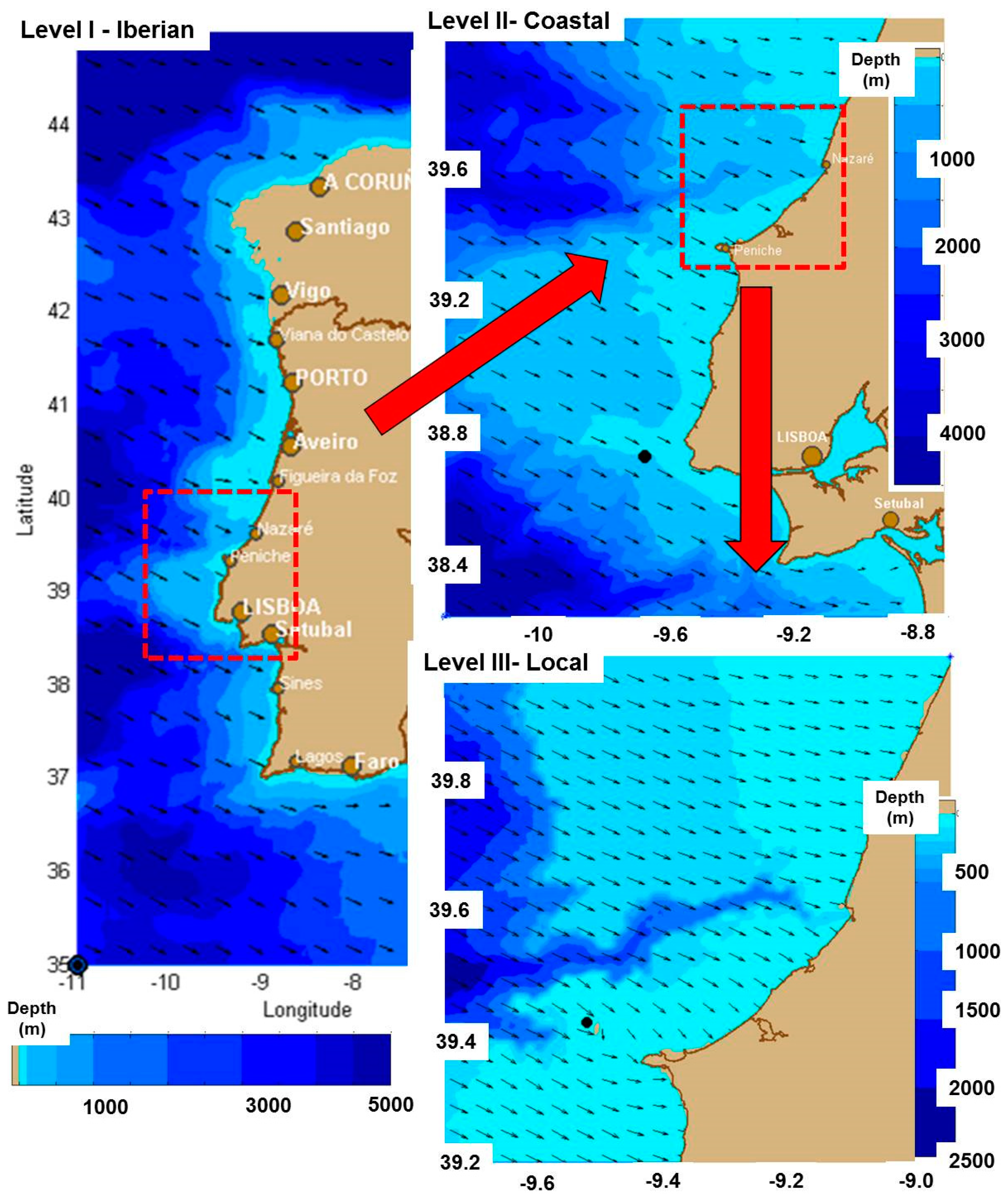
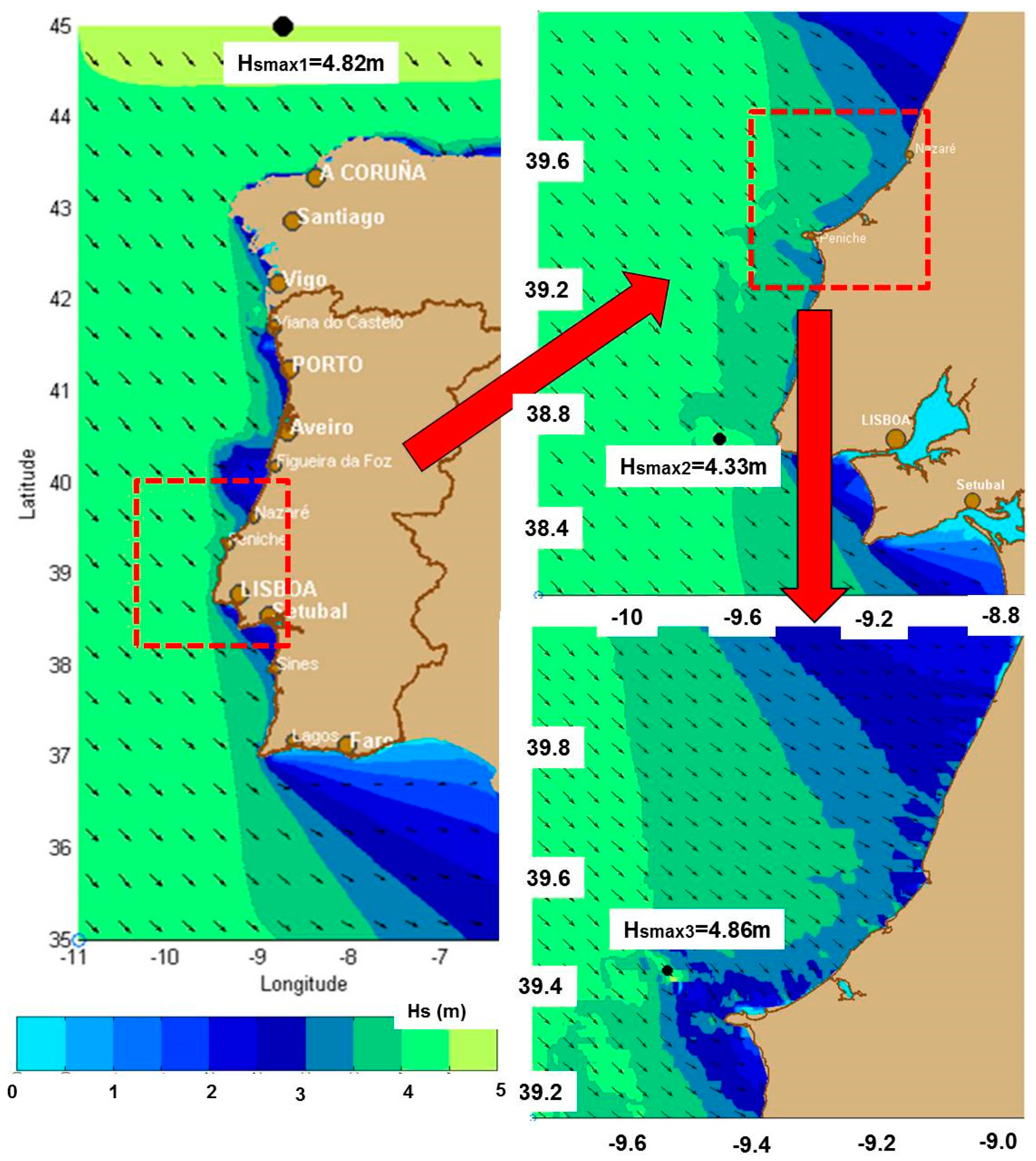


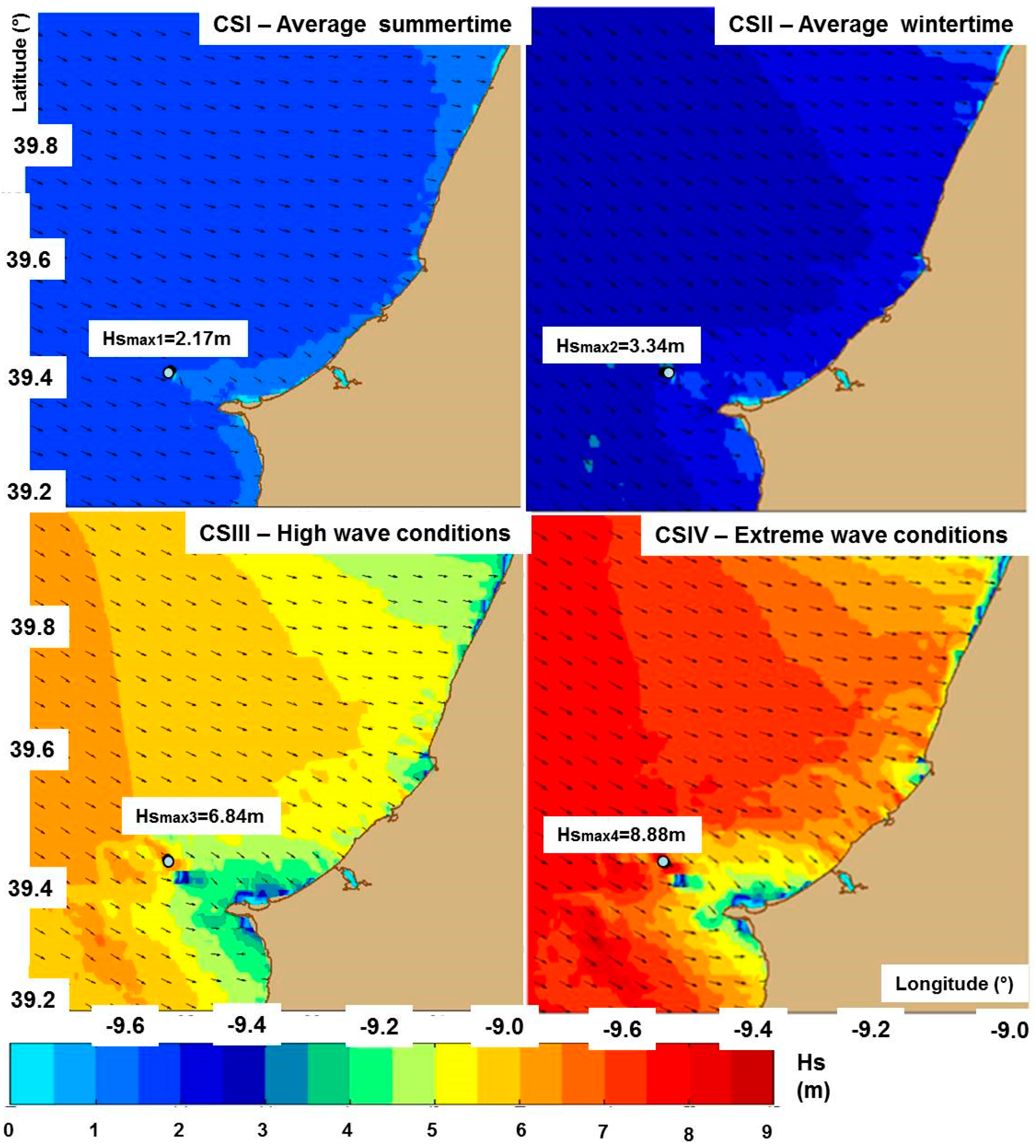
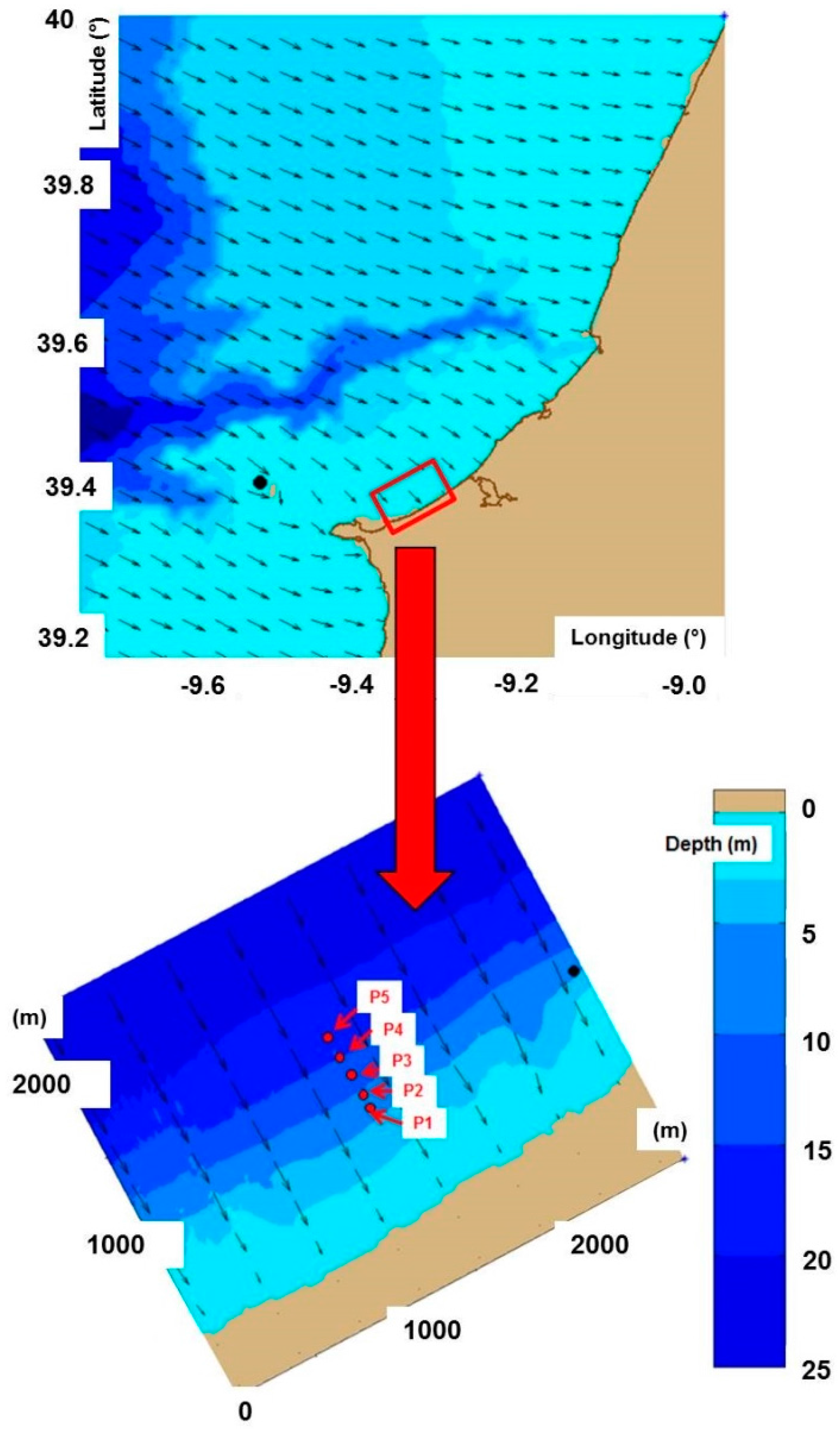
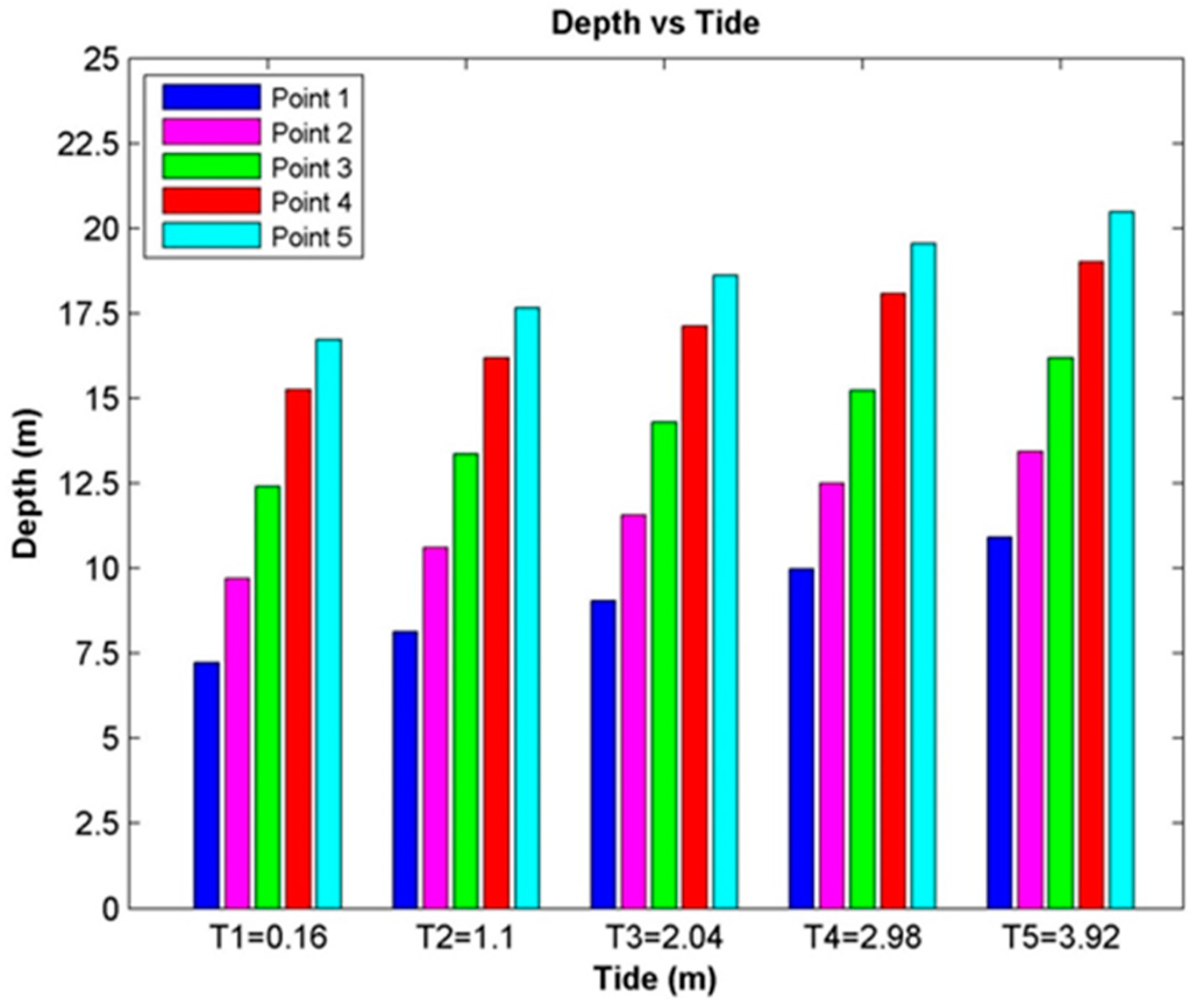
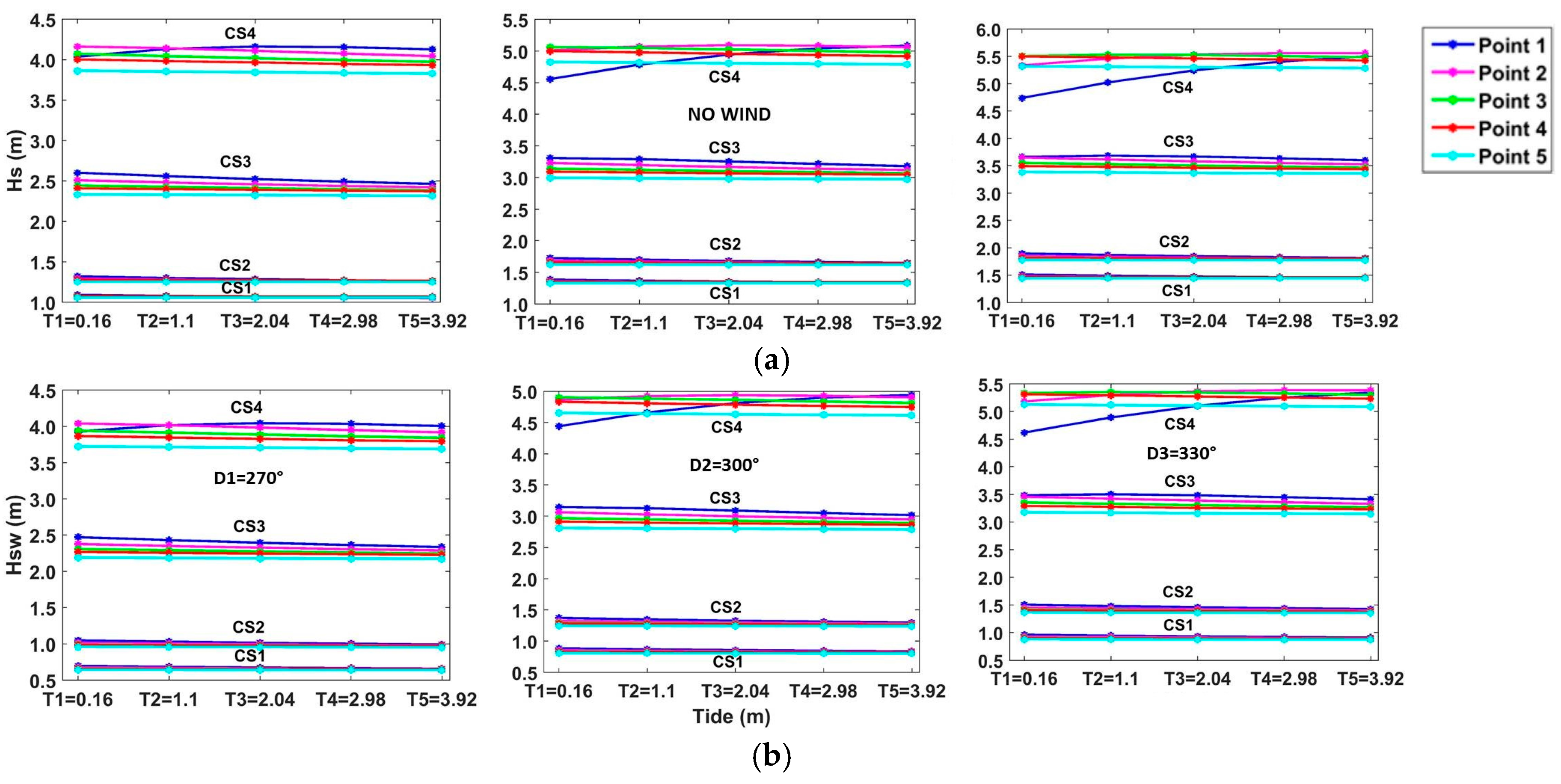
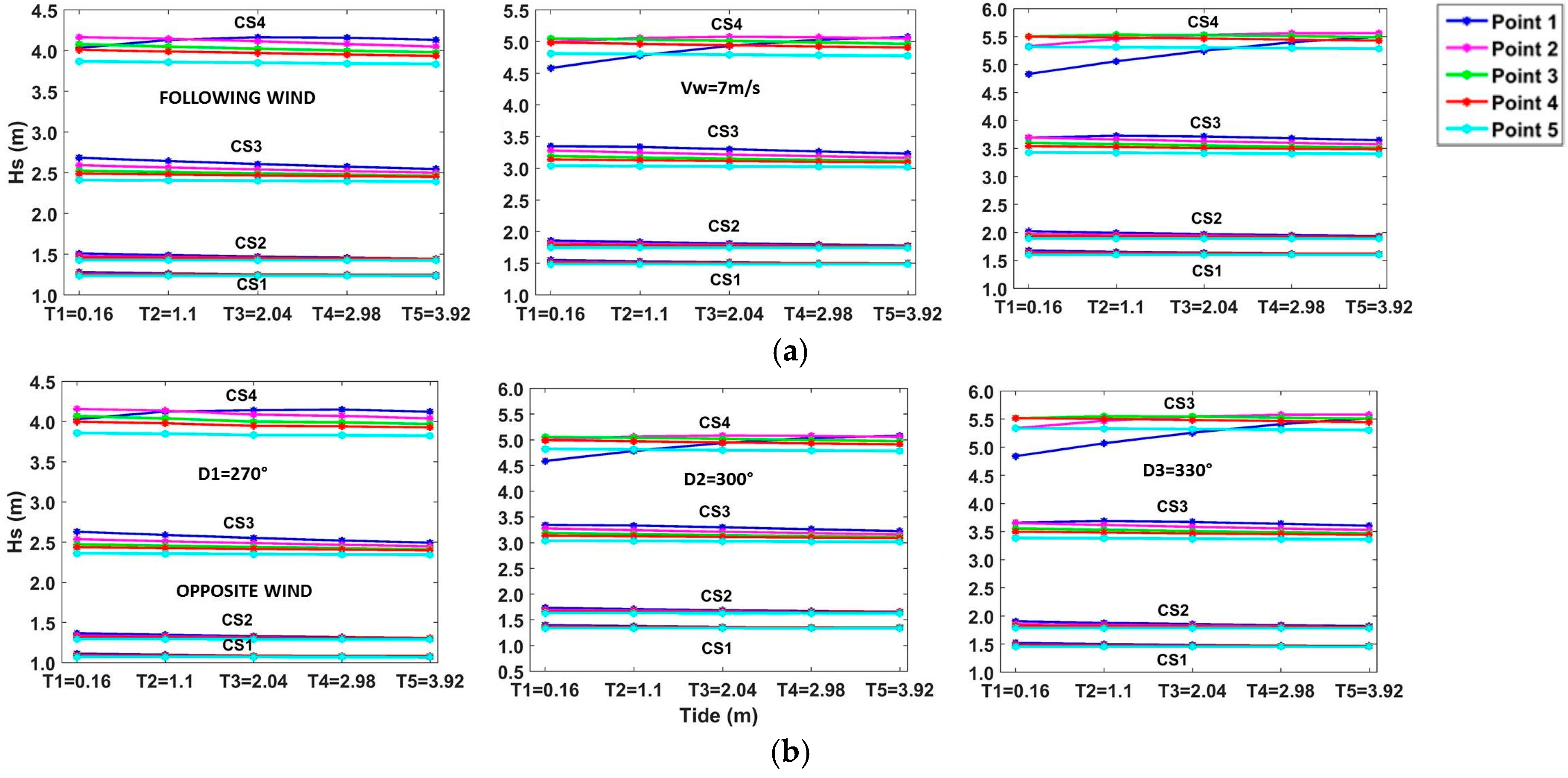
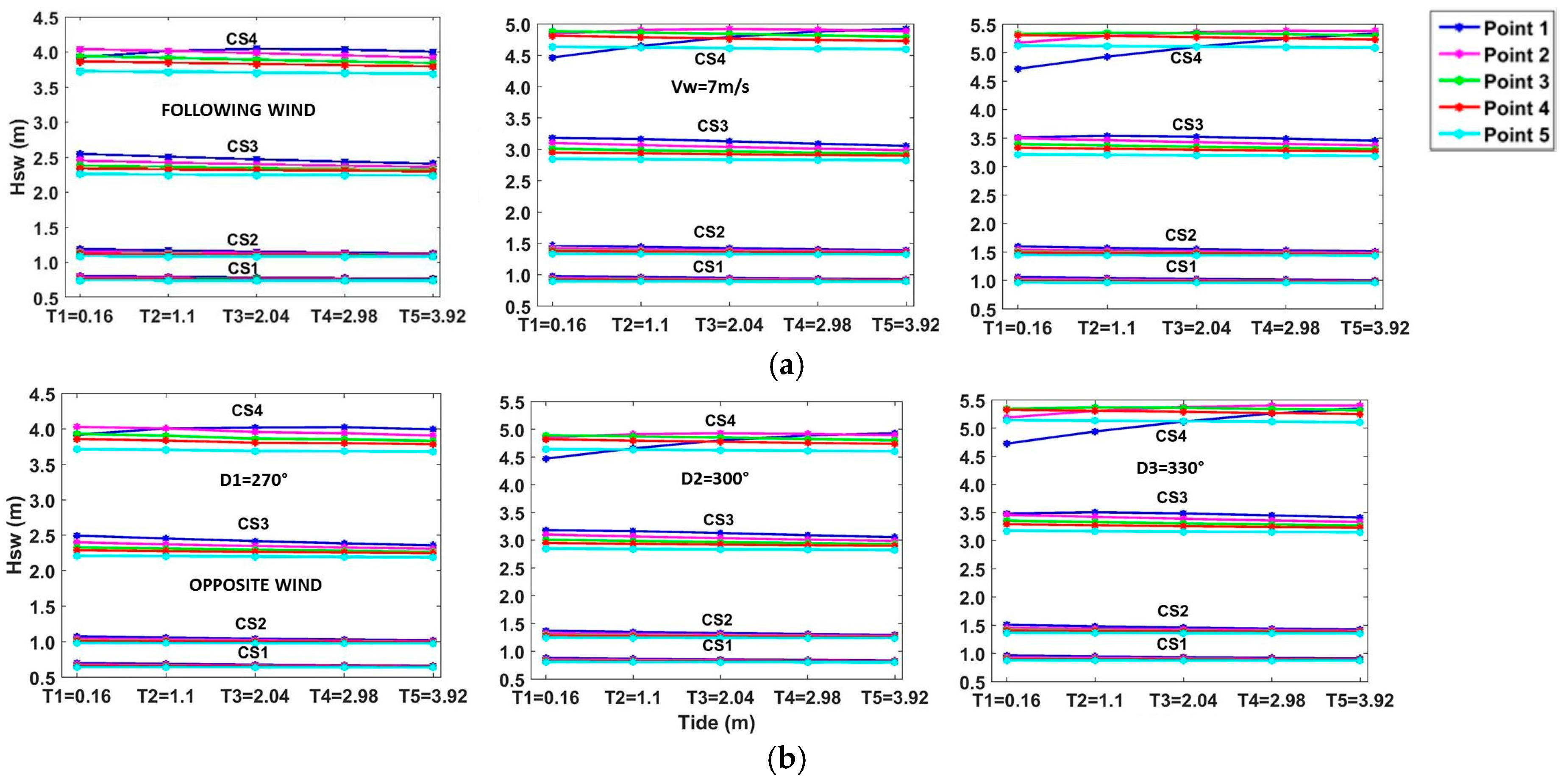
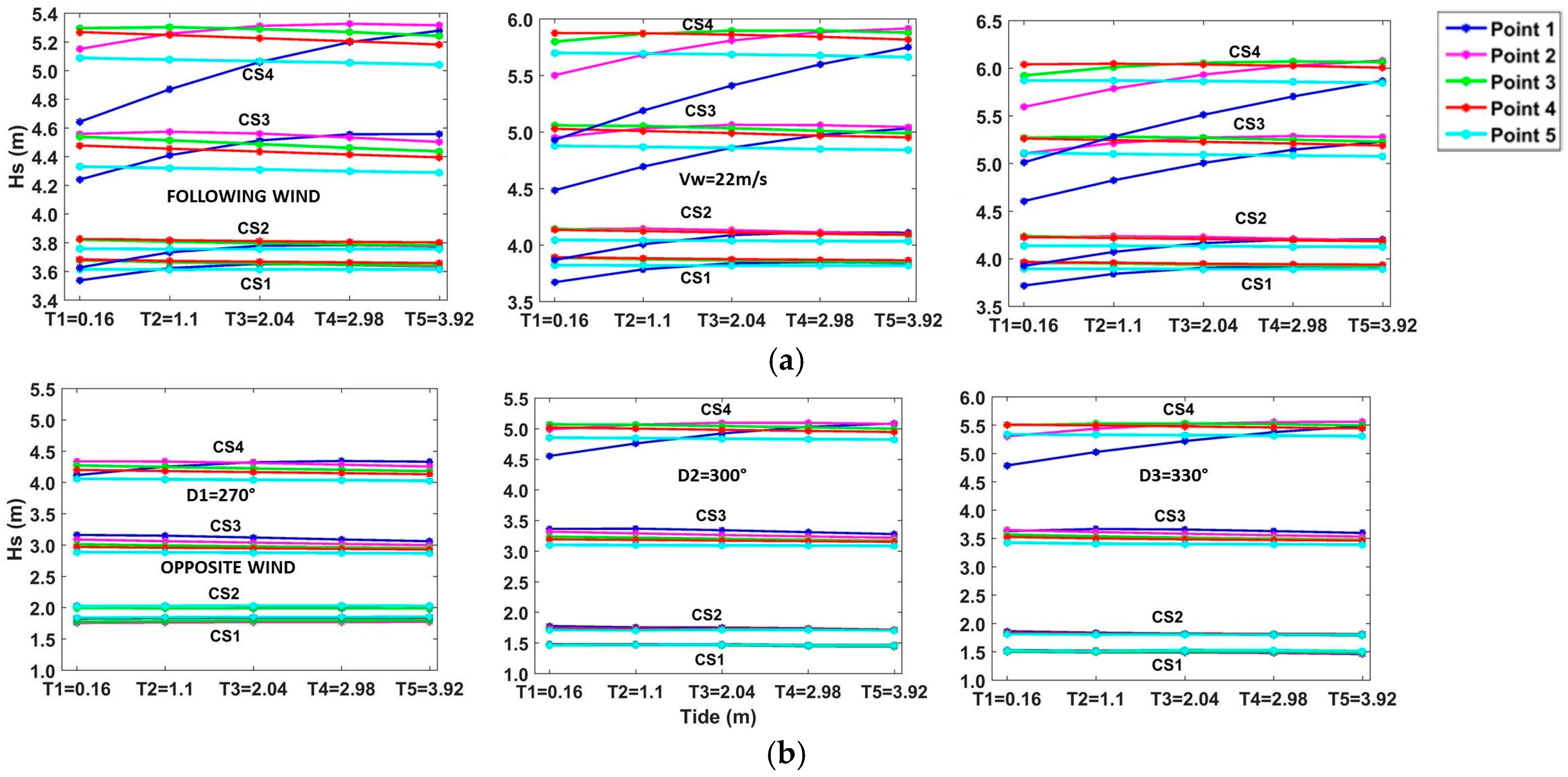
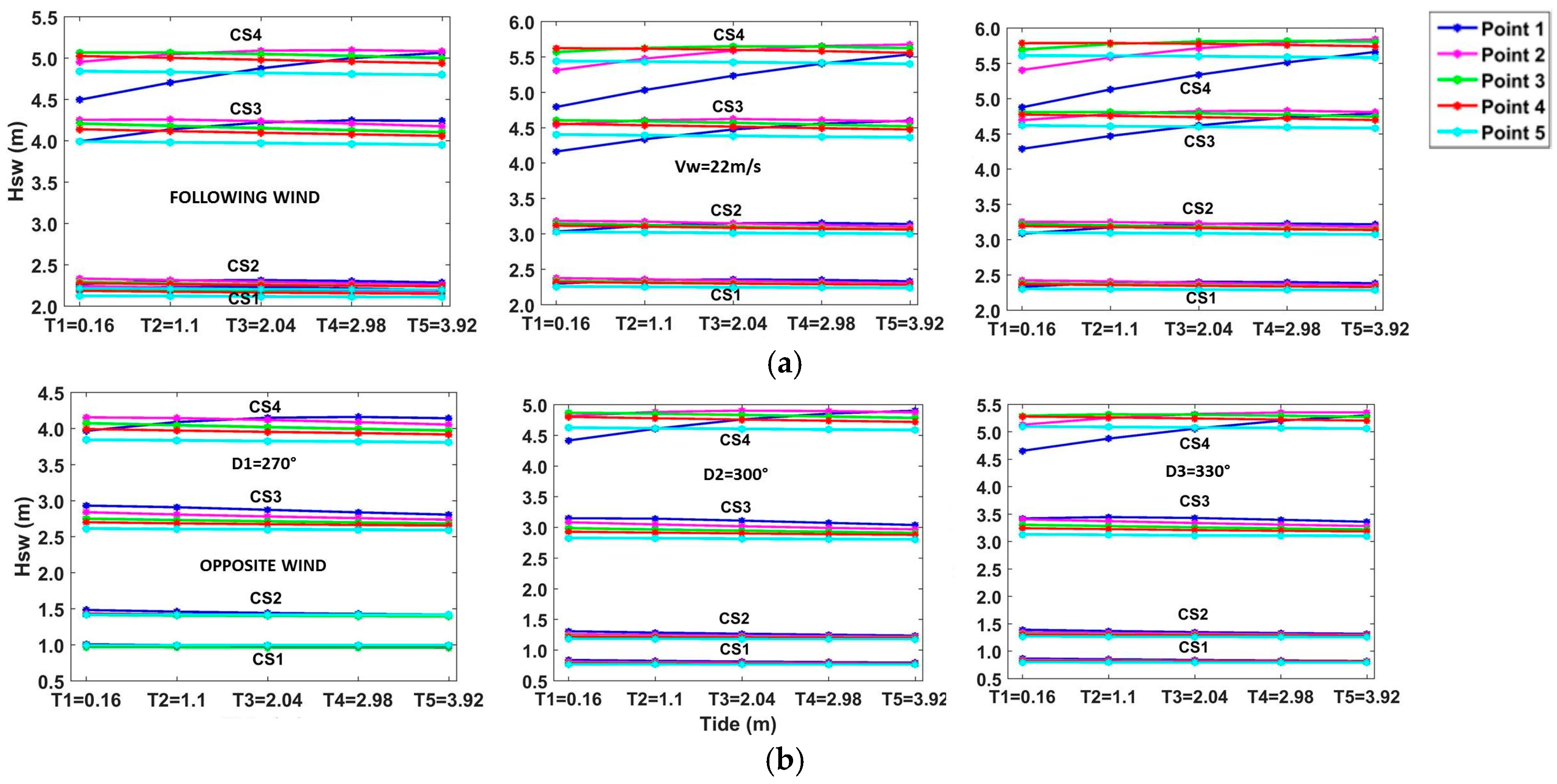

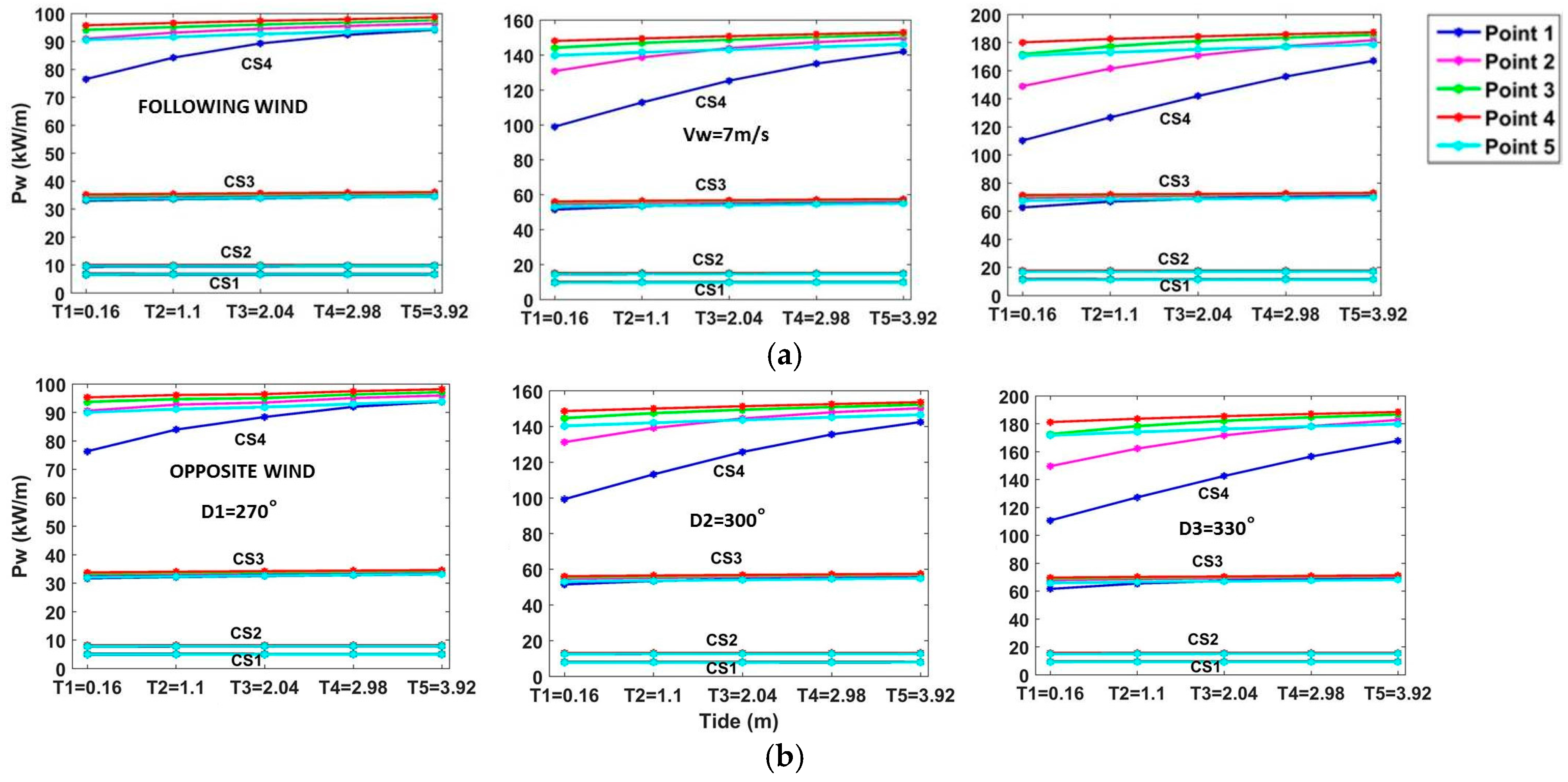
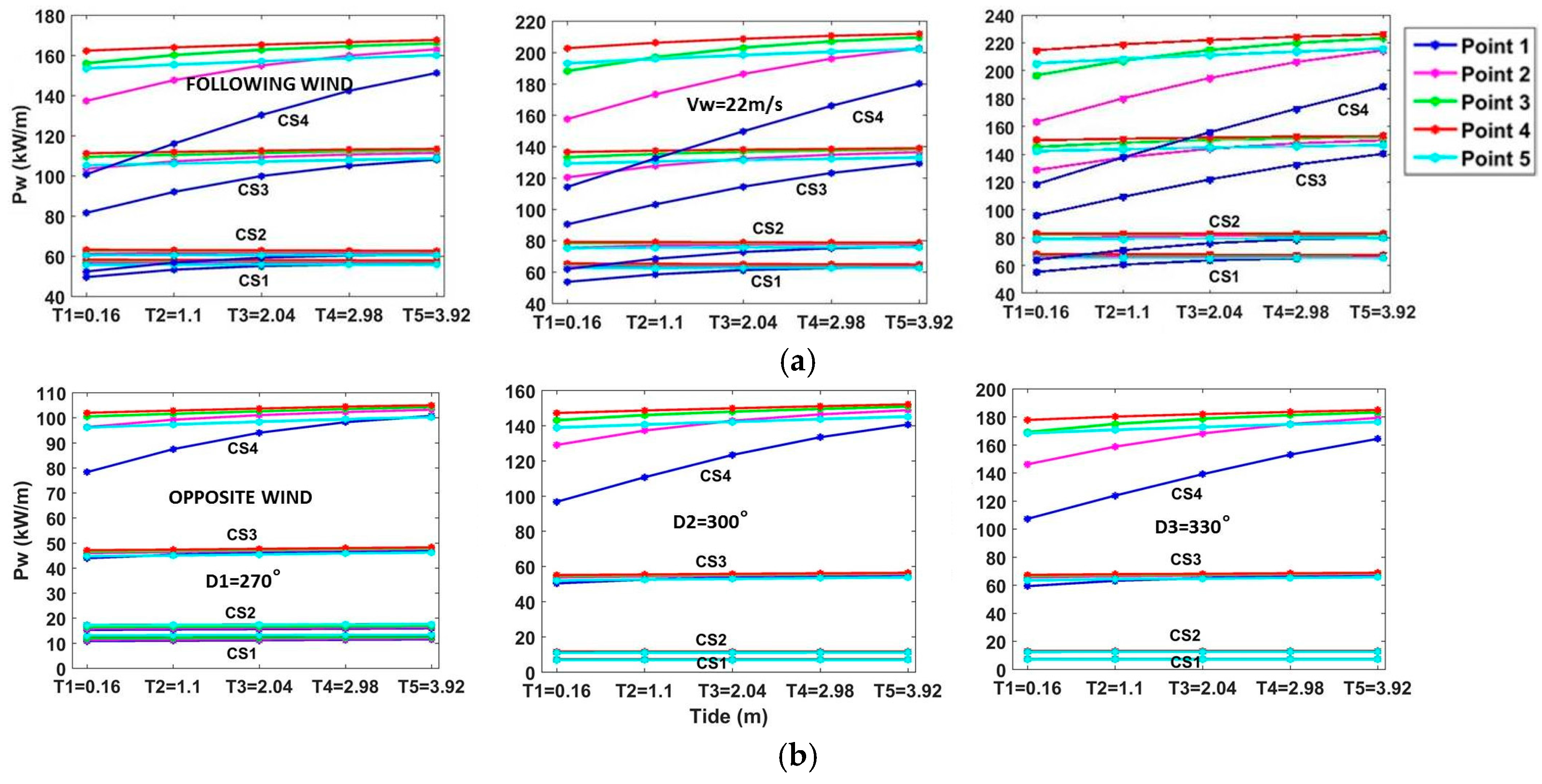
| Nomenclature | Significance |
|---|---|
| Δx/Δy | Resolution in the geographical space |
| Δθ | Resolution in the directional space |
| Δt | Time resolution |
| nf | Number of frequencies in the spectral space |
| nθ | Number of directions in the spectral space |
| ngx | Number of grid points in x direction |
| ngy | Number of grid points in y direction |
| np | Total number of grid points |
| wave | Wave forcing |
| wind | Wind forcing |
| tide | Tide forcing |
| cur | Current field input |
| gen | Generation by wind |
| wcap | Whitecapping process |
| quad | Quadruplet nonlinear interactions |
| tri | Triad nonlinear interactions |
| dif | Diffraction |
| bfr | Bottom friction |
| set up | Wave induced set up |
| br | Depth induced wave breaking |
| SWAN Model | Origin | Δx × Δy | Δθ (°) | Mode | nf | nθ | ngx × ngy = np | |||||
|---|---|---|---|---|---|---|---|---|---|---|---|---|
| Level I Iberian | XO1 = −11° W YO1 = 35° N | 0.05 × 0.1 (°) | 10 | nonstat | 29 | 36 | 100 × 100 = 10,000 | |||||
| Level II Coastal | XO2 = −10.25° W YO2 = 38.25° N | 0.02 × 0.02 (°) | 10 | nonstat | 29 | 36 | 75 × 90 = 6750 | |||||
| Level III Local | XO3 = −9.75° W YO3 = 39.2° N | 0.005 × 0.005 (°) | 10 | nonstat | 29 | 36 | 161 × 161 = 25,921 | |||||
| Level IV High Resolution | XO4 = −9.315° W YO4 = 39.398° N | 25 × 25 (m) | 5 | stat | 34 | 36 | 112 × 96 = 10,752 | |||||
| Input/Process | Wave | Wind | Tide | Cur | Gen | Wcap | Quad | Tri | Dif | Bfr | Set up | Br |
| Level I Iberian | X | X | 0 | 0 | X | X | X | 0 | 0 | X | 0 | X |
| Level II Coastal | X | X | 0 | 0 | X | X | X | 0 | 0 | X | 0 | X |
| Level III Local | X | X | X | 0 | X | X | X | X | X | X | X | X |
| Level IV High Resolution | X | X | X | 0 | X | X | X | X | X | X | X | X |
| Case Study | Hs (m) | Tp (s) | |||
|---|---|---|---|---|---|
| CSI (total average) | 2.0 | 10.1 | |||
| CSII (winter average) | 2.43 | 11.0 | |||
| CSIII (high waves) | 4.5 | 15.0 | |||
| CSIV (extreme conditions) | 8.7 | 18.0 | |||
| Mean Wave Direction (°) Nautical Convention | Wind Conditions | ||||
| Wind Velocity (m/s) | Wind Direction (°) | ||||
| Dir1 | 270 | W0 (no wind) | 0 | - | |
| W7 (average wind) | 7 | FW (following wind) | 305 | ||
| OW (opposite wind) | 90 | ||||
| W22 (high wind) | 22 | FW (following wind) | 305 | ||
| OW (opposite wind) | 90 | ||||
| Dir2 | 300 | W0 (no wind) | 0 | - | |
| W7 (average wind) | 7 | FW (following wind) | 305 | ||
| OW (opposite wind) | 120 | ||||
| W22 (high wind) | 22 | FW (following wind) | 305 | ||
| OW (opposite wind) | 120 | ||||
| Dir3 | 330 | W0 (no wind) | 0 | - | |
| W7 (average wind) | 7 | FW (following wind) | 305 | ||
| OW (opposite wind) | 150 | ||||
| W22 (high wind) | 22 | FW (following wind) | 305 | ||
| OW (opposite wind) | 150 | ||||
| Tide Level | T1 | T2 | T3 | T4 | T5 |
| (m)-above the hydrographic zero | 0.16 | 1.1 | 2.04 | 2.98 | 3.92 |
| CS1 | P3 | P4 | P5 | ||||||||
|---|---|---|---|---|---|---|---|---|---|---|---|
| Hs | Hsw | Pw | Hs | Hsw | Pw | Hs | Hsw | Pw | |||
| m | m | kW/m | m | m | kW/m | m | m | kW/m | |||
| D1 | W0 | T1 | 1.07 | 0.67 | 5.16 | 1.08 | 0.66 | 5.26 | 1.06 | 0.64 | 5.06 |
| T5 | 1.06 | 0.65 | 5.15 | 1.07 | 0.65 | 5.22 | 1.06 | 0.64 | 5.07 | ||
| W7-FW | T1 | 1.25 | 0.77 | 6.91 | 1.26 | 0.77 | 7.03 | 1.24 | 0.75 | 6.76 | |
| T5 | 1.24 | 0.75 | 6.90 | 1.25 | 0.75 | 6.98 | 1.24 | 0.74 | 6.78 | ||
| W7-OW | T1 | 1.09 | 0.67 | 5.19 | 1.09 | 0.66 | 5.27 | 1.07 | 0.65 | 5.06 | |
| T5 | 1.07 | 0.65 | 5.17 | 1.08 | 0.65 | 5.23 | 1.07 | 0.64 | 5.08 | ||
| W22-FW | T1 | 3.68 | 2.21 | 57.89 | 3.68 | 2.19 | 58.44 | 3.62 | 2.13 | 55.91 | |
| T5 | 3.64 | 2.15 | 57.70 | 3.66 | 2.15 | 57.98 | 3.62 | 2.11 | 56.07 | ||
| W22-OW | T1 | 1.78 | 0.97 | 12.01 | 1.83 | 0.99 | 12.90 | 1.84 | 1.00 | 13.10 | |
| T5 | 1.80 | 0.97 | 12.44 | 1.84 | 0.99 | 13.17 | 1.85 | 1.00 | 13.35 | ||
| D2 | W0 | T1 | 1.35 | 0.84 | 8.21 | 1.36 | 0.83 | 8.32 | 1.33 | 0.81 | 7.97 |
| T5 | 1.34 | 0.82 | 8.19 | 1.35 | 0.82 | 8.25 | 1.33 | 0.81 | 8.00 | ||
| W7-FW | T1 | 1.51 | 0.93 | 10.11 | 1.52 | 0.93 | 10.24 | 1.49 | 0.90 | 9.81 | |
| T5 | 1.49 | 0.91 | 10.08 | 1.51 | 0.91 | 10.16 | 1.49 | 0.89 | 9.85 | ||
| W7-OW | T1 | 1.36 | 0.84 | 8.21 | 1.37 | 0.83 | 8.31 | 1.34 | 0.81 | 7.96 | |
| T5 | 1.35 | 0.82 | 8.18 | 1.36 | 0.82 | 8.25 | 1.34 | 0.81 | 7.99 | ||
| W22-FW | T1 | 3.89 | 2.34 | 65.04 | 3.89 | 2.32 | 65.66 | 3.82 | 2.26 | 62.75 | |
| T5 | 3.85 | 2.29 | 64.79 | 3.87 | 2.28 | 65.05 | 3.82 | 2.24 | 62.87 | ||
| W22-OW | T1 | 1.47 | 0.80 | 7.28 | 1.48 | 0.79 | 7.38 | 1.47 | 0.77 | 7.08 | |
| T5 | 1.45 | 0.78 | 7.28 | 1.47 | 0.78 | 7.34 | 1.46 | 0.77 | 7.12 | ||
| D3 | W0 | T1 | 1.47 | 0.91 | 9.71 | 1.48 | 0.91 | 9.82 | 1.45 | 0.88 | 9.40 |
| T5 | 1.45 | 0.89 | 9.68 | 1.47 | 0.89 | 9.74 | 1.45 | 0.88 | 9.43 | ||
| W7-FW | T1 | 1.63 | 1.01 | 11.78 | 1.64 | 1.00 | 11.90 | 1.61 | 0.97 | 11.39 | |
| T5 | 1.61 | 0.98 | 11.74 | 1.62 | 0.98 | 11.81 | 1.61 | 0.96 | 11.44 | ||
| W7-OW | T1 | 1.48 | 0.91 | 9.70 | 1.49 | 0.91 | 9.81 | 1.46 | 0.88 | 9.39 | |
| T5 | 1.46 | 0.89 | 9.67 | 1.47 | 0.89 | 9.74 | 1.46 | 0.88 | 9.43 | ||
| W22-FW | T1 | 3.96 | 2.39 | 67.65 | 3.97 | 2.37 | 68.25 | 3.90 | 2.31 | 65.21 | |
| T5 | 3.92 | 2.33 | 67.40 | 3.94 | 2.33 | 67.62 | 3.89 | 2.29 | 65.35 | ||
| W22-OW | T1 | 1.51 | 0.83 | 7.66 | 1.53 | 0.83 | 7.74 | 1.52 | 0.80 | 7.37 | |
| T5 | 1.49 | 0.81 | 7.64 | 1.52 | 0.81 | 7.68 | 1.52 | 0.80 | 7.41 | ||
| CS2 | P3 | P4 | P5 | ||||||||
|---|---|---|---|---|---|---|---|---|---|---|---|
| Hs | Hsw | Pw | Hs | Hsw | Pw | Hs | Hsw | Pw | |||
| m | m | kW/m | m | m | kW/m | m | m | kW/m | |||
| D1 | W0 | T1 | 1.28 | 1.00 | 7.77 | 1.28 | 0.99 | 7.91 | 1.25 | 0.96 | 7.57 |
| T5 | 1.26 | 0.97 | 7.80 | 1.27 | 0.98 | 7.90 | 1.25 | 0.96 | 7.65 | ||
| W7-FW | T1 | 1.46 | 1.13 | 9.97 | 1.46 | 1.12 | 10.15 | 1.43 | 1.09 | 9.72 | |
| T5 | 1.44 | 1.10 | 10.01 | 1.45 | 1.10 | 10.13 | 1.43 | 1.08 | 9.81 | ||
| W7-OW | T1 | 1.32 | 1.02 | 8.16 | 1.32 | 1.02 | 8.29 | 1.30 | 0.99 | 7.93 | |
| T5 | 1.30 | 1.00 | 8.19 | 1.31 | 1.00 | 8.28 | 1.29 | 0.98 | 8.01 | ||
| W22-FW | T1 | 3.82 | 2.30 | 62.75 | 3.83 | 2.28 | 63.41 | 3.76 | 2.22 | 60.64 | |
| T5 | 3.78 | 2.24 | 62.51 | 3.80 | 2.24 | 62.82 | 3.76 | 2.20 | 60.75 | ||
| W22-OW | T1 | 2.00 | 1.42 | 16.48 | 2.03 | 1.43 | 17.35 | 2.03 | 1.42 | 17.30 | |
| T5 | 2.00 | 1.40 | 16.90 | 2.03 | 1.42 | 17.65 | 2.03 | 1.42 | 17.65 | ||
| D2 | W0 | T1 | 1.67 | 1.30 | 13.13 | 1.66 | 1.29 | 13.30 | 1.63 | 1.25 | 12.70 |
| T5 | 1.64 | 1.27 | 13.17 | 1.65 | 1.27 | 13.28 | 1.62 | 1.24 | 12.83 | ||
| W7-FW | T1 | 1.80 | 1.39 | 15.10 | 1.79 | 1.38 | 15.30 | 1.76 | 1.34 | 14.61 | |
| T5 | 1.77 | 1.36 | 15.15 | 1.78 | 1.36 | 15.27 | 1.75 | 1.33 | 14.75 | ||
| W7-OW | T1 | 1.67 | 1.30 | 13.13 | 1.67 | 1.29 | 13.29 | 1.64 | 1.25 | 12.69 | |
| T5 | 1.63 | 1.27 | 13.17 | 1.65 | 1.27 | 13.27 | 1.63 | 1.24 | 12.82 | ||
| W22-FW | T1 | 4.15 | 3.15 | 78.44 | 4.14 | 3.12 | 79.26 | 4.05 | 3.03 | 75.53 | |
| T5 | 4.09 | 3.07 | 78.65 | 4.09 | 3.06 | 78.99 | 4.03 | 3.00 | 76.15 | ||
| W22-OW | T1 | 1.73 | 1.23 | 11.70 | 1.74 | 1.22 | 11.79 | 1.73 | 1.19 | 11.22 | |
| T5 | 1.71 | 1.21 | 11.72 | 1.72 | 1.20 | 11.78 | 1.71 | 1.18 | 11.35 | ||
| D3 | W0 | T1 | 1.83 | 1.42 | 15.77 | 1.82 | 1.41 | 15.95 | 1.78 | 1.37 | 15.22 |
| T5 | 1.80 | 1.39 | 15.82 | 1.81 | 1.39 | 15.93 | 1.78 | 1.36 | 15.38 | ||
| W7-FW | T1 | 1.95 | 1.51 | 17.74 | 1.94 | 1.49 | 17.94 | 1.90 | 1.45 | 17.12 | |
| T5 | 1.92 | 1.47 | 17.80 | 1.92 | 1.47 | 17.92 | 1.90 | 1.44 | 17.30 | ||
| W7-OW | T1 | 1.83 | 1.42 | 15.76 | 1.83 | 1.41 | 15.94 | 1.79 | 1.37 | 15.20 | |
| T5 | 1.80 | 1.39 | 15.82 | 1.81 | 1.39 | 15.92 | 1.79 | 1.36 | 15.37 | ||
| W22-FW | T1 | 4.24 | 3.23 | 82.18 | 4.23 | 3.19 | 83.02 | 4.14 | 3.10 | 79.09 | |
| T5 | 4.18 | 3.15 | 82.45 | 4.19 | 3.14 | 82.76 | 4.13 | 3.08 | 79.76 | ||
| W22-OW | T1 | 1.83 | 1.32 | 13.25 | 1.84 | 1.31 | 13.38 | 1.82 | 1.27 | 12.72 | |
| T5 | 1.80 | 1.29 | 13.29 | 1.82 | 1.29 | 13.36 | 1.81 | 1.26 | 12.85 | ||
| CS3 | P3 | P4 | P5 | ||||||||
|---|---|---|---|---|---|---|---|---|---|---|---|
| Hs | Hsw | Pw | Hs | Hsw | Pw | Hs | Hsw | Pw | |||
| m | m | kW/m | m | m | kW/m | m | m | kW/m | |||
| D1 | W0 | T1 | 2.44 | 2.31 | 32.75 | 2.41 | 2.27 | 33.29 | 2.33 | 2.19 | 31.57 |
| T5 | 2.39 | 2.25 | 33.69 | 2.37 | 2.23 | 34.09 | 2.32 | 2.17 | 32.70 | ||
| W7-FW | T1 | 2.53 | 2.38 | 34.75 | 2.49 | 2.34 | 35.33 | 2.41 | 2.26 | 33.51 | |
| T5 | 2.47 | 2.32 | 35.75 | 2.45 | 2.30 | 36.17 | 2.39 | 2.24 | 34.70 | ||
| W7-OW | T1 | 2.47 | 2.33 | 33.33 | 2.44 | 2.29 | 33.87 | 2.36 | 2.21 | 32.11 | |
| T5 | 2.42 | 2.27 | 34.29 | 2.40 | 2.25 | 34.68 | 2.34 | 2.19 | 33.26 | ||
| W22-FW | T1 | 4.54 | 4.21 | 109.68 | 4.48 | 4.14 | 111.41 | 4.33 | 3.99 | 105.34 | |
| T5 | 4.44 | 4.10 | 112.73 | 4.40 | 4.06 | 113.60 | 4.29 | 3.95 | 108.73 | ||
| W22-OW | T1 | 3.01 | 2.75 | 46.59 | 2.97 | 2.70 | 47.22 | 2.89 | 2.62 | 44.76 | |
| T5 | 2.96 | 2.69 | 47.96 | 2.93 | 2.66 | 48.35 | 2.87 | 2.59 | 46.38 | ||
| D2 | W0 | T1 | 3.14 | 2.97 | 54.08 | 3.10 | 2.92 | 54.76 | 3.00 | 2.81 | 51.82 |
| T5 | 3.07 | 2.90 | 55.63 | 3.05 | 2.86 | 56.09 | 2.98 | 2.79 | 53.70 | ||
| W7-FW | T1 | 3.19 | 3.01 | 55.54 | 3.14 | 2.95 | 56.25 | 3.04 | 2.85 | 53.23 | |
| T5 | 3.12 | 2.93 | 57.13 | 3.09 | 2.90 | 57.61 | 3.02 | 2.83 | 55.15 | ||
| W7-OW | T1 | 3.19 | 3.01 | 55.52 | 3.14 | 2.95 | 56.22 | 3.04 | 2.85 | 53.20 | |
| T5 | 3.12 | 2.93 | 57.11 | 3.09 | 2.90 | 57.58 | 3.02 | 2.83 | 55.13 | ||
| W22-FW | T1 | 5.06 | 4.61 | 133.41 | 5.03 | 4.56 | 136.70 | 4.88 | 4.40 | 129.46 | |
| T5 | 4.99 | 4.52 | 138.28 | 4.95 | 4.48 | 139.18 | 4.84 | 4.37 | 133.25 | ||
| W22-OW | T1 | 3.24 | 2.99 | 54.63 | 3.20 | 2.93 | 55.21 | 3.10 | 2.83 | 52.16 | |
| T5 | 3.18 | 2.91 | 56.14 | 3.16 | 2.88 | 56.52 | 3.09 | 2.81 | 54.04 | ||
| D3 | W0 | T1 | 3.55 | 3.36 | 69.04 | 3.50 | 3.29 | 69.91 | 3.39 | 3.18 | 66.08 |
| T5 | 3.47 | 3.27 | 70.98 | 3.44 | 3.23 | 71.49 | 3.36 | 3.15 | 68.42 | ||
| W7-FW | T1 | 3.60 | 3.40 | 70.71 | 3.55 | 3.33 | 71.59 | 3.43 | 3.22 | 67.67 | |
| T5 | 3.52 | 3.31 | 72.69 | 3.49 | 3.27 | 73.21 | 3.41 | 3.19 | 70.06 | ||
| W7-OW | T1 | 3.56 | 3.36 | 69.03 | 3.50 | 3.29 | 69.89 | 3.39 | 3.18 | 66.06 | |
| T5 | 3.48 | 3.27 | 70.96 | 3.45 | 3.23 | 71.47 | 3.37 | 3.15 | 68.40 | ||
| W22-FW | T1 | 5.27 | 4.81 | 145.20 | 5.27 | 4.78 | 150.01 | 5.11 | 4.62 | 142.18 | |
| T5 | 5.23 | 4.74 | 152.12 | 5.19 | 4.70 | 153.03 | 5.08 | 4.58 | 146.51 | ||
| W22-OW | T1 | 3.57 | 3.31 | 66.78 | 3.53 | 3.25 | 67.54 | 3.43 | 3.13 | 63.75 | |
| T5 | 3.49 | 3.22 | 68.62 | 3.47 | 3.19 | 69.07 | 3.39 | 3.10 | 66.03 | ||
| CS3 | P3 | P4 | P5 | ||||||||
|---|---|---|---|---|---|---|---|---|---|---|---|
| Hs | Hsw | Pw | Hs | Hsw | Pw | Hs | Hsw | Pw | |||
| m | m | kW/m | m | m | kW/m | m | m | kW/m | |||
| D1 | W0 | T1 | 4.07 | 3.94 | 94.21 | 4.01 | 3.87 | 95.84 | 3.86 | 3.72 | 90.59 |
| T5 | 3.97 | 3.84 | 97.64 | 3.93 | 3.80 | 98.71 | 3.83 | 3.69 | 94.45 | ||
| W7-FW | T1 | 4.08 | 3.94 | 94.23 | 4.01 | 3.87 | 95.86 | 3.87 | 3.72 | 90.61 | |
| T5 | 3.98 | 3.84 | 97.66 | 3.94 | 3.80 | 98.73 | 3.84 | 3.69 | 94.46 | ||
| W7-OW | T1 | 4.07 | 3.93 | 93.79 | 4.00 | 3.86 | 95.38 | 3.86 | 3.72 | 90.14 | |
| T5 | 3.97 | 3.83 | 97.20 | 3.93 | 3.79 | 98.24 | 3.83 | 3.68 | 93.98 | ||
| W22-FW | T1 | 5.30 | 5.07 | 156.25 | 5.27 | 5.03 | 162.48 | 5.09 | 4.84 | 153.65 | |
| T5 | 5.24 | 5.00 | 166.23 | 5.18 | 4.94 | 167.84 | 5.04 | 4.80 | 160.26 | ||
| W22-OW | T1 | 4.27 | 4.08 | 100.59 | 4.20 | 3.99 | 102.07 | 4.06 | 3.85 | 96.26 | |
| T5 | 4.18 | 3.97 | 104.26 | 4.13 | 3.92 | 105.08 | 4.03 | 3.81 | 100.34 | ||
| D2 | W0 | T1 | 5.06 | 4.90 | 145.29 | 5.00 | 4.83 | 149.32 | 4.83 | 4.65 | 140.98 |
| T5 | 4.98 | 4.81 | 152.91 | 4.92 | 4.75 | 154.30 | 4.79 | 4.61 | 147.30 | ||
| W7-FW | T1 | 5.05 | 4.88 | 144.25 | 4.99 | 4.81 | 148.18 | 4.81 | 4.64 | 139.90 | |
| T5 | 4.96 | 4.79 | 151.76 | 4.91 | 4.73 | 153.13 | 4.78 | 4.60 | 146.17 | ||
| W7-OW | T1 | 5.06 | 4.90 | 144.76 | 5.00 | 4.82 | 148.73 | 4.82 | 4.65 | 140.42 | |
| T5 | 5.00 | 4.80 | 152.33 | 4.92 | 4.74 | 153.70 | 4.79 | 4.61 | 146.72 | ||
| W22-FW | T1 | 5.80 | 5.57 | 188.31 | 5.88 | 5.62 | 202.92 | 5.70 | 5.44 | 193.22 | |
| T5 | 5.88 | 5.63 | 209.82 | 5.82 | 5.56 | 212.07 | 5.66 | 5.40 | 202.40 | ||
| W22-OW | T1 | 5.07 | 4.87 | 143.18 | 5.02 | 4.80 | 147.30 | 4.86 | 4.63 | 139.02 | |
| T5 | 5.00 | 4.78 | 150.93 | 4.95 | 4.72 | 152.22 | 4.82 | 4.59 | 145.24 | ||
| D3 | W0 | T1 | 5.51 | 5.34 | 172.14 | 5.50 | 5.32 | 180.55 | 5.32 | 5.13 | 170.96 |
| T5 | 5.49 | 5.30 | 185.7 | 5.43 | 5.24 | 187.44 | 5.29 | 5.09 | 178.93 | ||
| W7-FW | T1 | 5.51 | 5.33 | 171.81 | 5.50 | 5.31 | 180.28 | 5.32 | 5.13 | 170.79 | |
| T5 | 5.49 | 5.30 | 185.67 | 5.43 | 5.24 | 187.41 | 5.29 | 5.09 | 178.91 | ||
| W7-OW | T1 | 5.52 | 5.35 | 172.72 | 5.52 | 5.33 | 181.39 | 5.34 | 5.14 | 171.88 | |
| T5 | 5.51 | 5.32 | 186.87 | 5.45 | 5.25 | 188.63 | 5.31 | 5.11 | 180.08 | ||
| W22-FW | T1 | 5.92 | 5.70 | 196.67 | 6.04 | 5.79 | 214.67 | 5.87 | 5.61 | 205.16 | |
| T5 | 6.07 | 5.81 | 223.35 | 6.01 | 5.74 | 226.15 | 5.85 | 5.58 | 215.77 | ||
| W22-OW | T1 | 5.50 | 5.30 | 169.33 | 5.51 | 5.28 | 178.00 | 5.34 | 5.10 | 168.61 | |
| T5 | 5.50 | 5.28 | 183.41 | 5.45 | 5.21 | 185.08 | 5.31 | 5.06 | 176.60 | ||
© 2016 by the authors; licensee MDPI, Basel, Switzerland. This article is an open access article distributed under the terms and conditions of the Creative Commons Attribution (CC-BY) license (http://creativecommons.org/licenses/by/4.0/).
Share and Cite
Silva, D.; Rusu, E.; Guedes Soares, C. High-Resolution Wave Energy Assessment in Shallow Water Accounting for Tides. Energies 2016, 9, 761. https://doi.org/10.3390/en9090761
Silva D, Rusu E, Guedes Soares C. High-Resolution Wave Energy Assessment in Shallow Water Accounting for Tides. Energies. 2016; 9(9):761. https://doi.org/10.3390/en9090761
Chicago/Turabian StyleSilva, Dina, Eugen Rusu, and Carlos Guedes Soares. 2016. "High-Resolution Wave Energy Assessment in Shallow Water Accounting for Tides" Energies 9, no. 9: 761. https://doi.org/10.3390/en9090761






